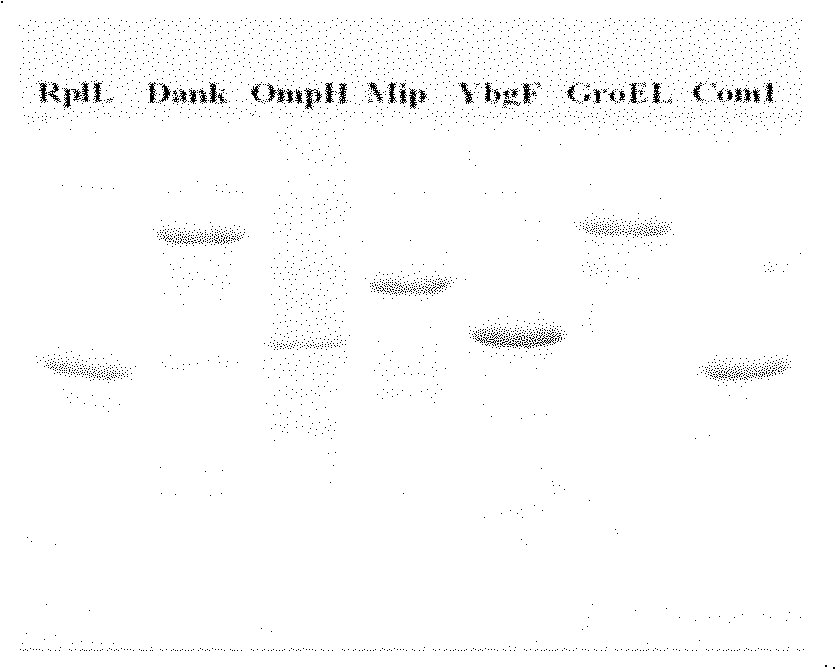Protein combination for diagnosing Q fever
A composition and protein technology, applied in the field of protein composition for diagnosing Q fever, can solve the problems of high cost, high protection requirements, large sample demand and the like
- Summary
- Abstract
- Description
- Claims
- Application Information
AI Technical Summary
Problems solved by technology
Method used
Image
Examples
Embodiment 1
[0082] The preparation of embodiment 1, 7 kinds of antigenic proteins
[0083] The vector pET-32a(+) was purchased from Novagen, the product catalog number is 69015. pQE30 was purchased from Qiagen Company, the product catalog number is 33203.
[0084] Escherichia coli BL21 was purchased from Novagen, the product catalog number is 69450. Escherichia coli M15 was purchased from Novagen, the product catalog number is 34210.
[0085] 1. Protein sequences and coding gene sequences of seven antigenic proteins
[0086] The protein sequences and coding gene sequences of the seven antigenic proteins are shown in Table 1.
[0087] Table 1, protein and gene sequence
[0088] protein name
protein sequence
coding gene sequence
OMP
SEQ ID NO: 1
SEQ ID NO: 8
Com1
SEQ ID NO: 2
SEQ ID NO: 9
wxya
SEQ ID NO: 3
SEQ ID NO: 10
Mip
SEQ ID NO: 4
SEQ ID NO: 11
DnaK
SEQ ID NO: 5
SEQ ID NO: 12
GroEL ...
Embodiment 2
[0115] Embodiment 2, protein chip and its preparation
[0116] Mouse IgG was purchased from Beijing Hongyue Innovation Biotechnology Co., Ltd., the product catalog number is M401-M422. Human IgG was purchased from Beijing Hongyue Innovation Biotechnology Co., Ltd., the product catalog number is M401-M422.
[0117] 1. Protein chip for detecting human serum and its preparation
[0118] The structure of the protein chip: it is composed of an aldylated slide substrate, a detection point, a positive quality control point and a negative quality control point, and the detection point, the positive quality control point and the negative quality control point are all spotted on the substrate. There were 5 replicates for each detection point, positive quality control point and negative quality control point. Detection points, positive quality control points and negative quality control points are arranged in a matrix on the substrate.
[0119] The detection points are divided into se...
Embodiment 3
[0128] Embodiment 3, diagnosis Q fever
[0129] Cy5-labeled goat anti-mouse IgG was purchased from KPL, USA, and the product catalog number was 072-02-18-06.
[0130] Cy5-labeled goat anti-human IgG was purchased from KPL, USA, and the product catalog number was 072-02-10-06.
[0131] Each 1 liter of phosphate buffered saline (PBS) is prepared as follows: 8gNaCl, 0.2gKCl, 3.53gNa 2 HPO 4 .12H 2 O, 0.24g KH 2 PO 4 Mix with water, and dilute to 1 liter with water, and the pH value of the obtained solution is 7.4, that is, the PBS buffer solution is obtained.
[0132] Every 1 liter of PBST buffer was prepared as follows: phosphate buffer (PBS) was mixed with Tween-20, and the ratio of phosphate buffer (PBS) and Tween-20 was 1 liter: 1 ml to obtain PBST buffer.
[0133] The mice were 6-week-old male BALB / c mice purchased from the Experimental Animal Center of the Academy of Military Medical Sciences.
[0134] 1. Diagnosis of Q fever in mice
[0135] (1) The composition of ...
PUM
 Login to View More
Login to View More Abstract
Description
Claims
Application Information
 Login to View More
Login to View More - R&D
- Intellectual Property
- Life Sciences
- Materials
- Tech Scout
- Unparalleled Data Quality
- Higher Quality Content
- 60% Fewer Hallucinations
Browse by: Latest US Patents, China's latest patents, Technical Efficacy Thesaurus, Application Domain, Technology Topic, Popular Technical Reports.
© 2025 PatSnap. All rights reserved.Legal|Privacy policy|Modern Slavery Act Transparency Statement|Sitemap|About US| Contact US: help@patsnap.com



